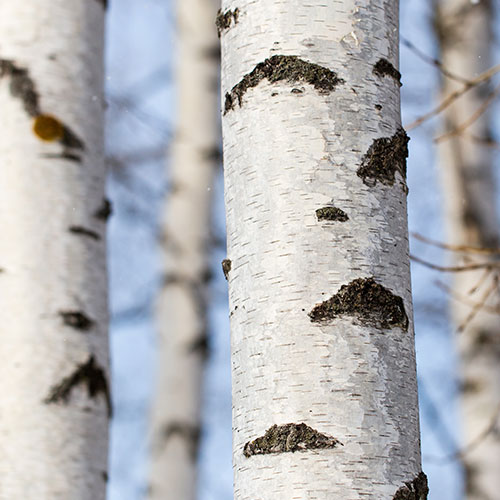PAPER BIRCH
Betula papyrifera
Plant Symbol = BEPAk
Additional Information
Alternative Names
White birch (B. p. var. paperifera), paperbark birch, silver birch, canoe birch; western paper birch (B. p. var. commutata), mountain paper birch (B. p. var. cordifolia), Kenai birch (B. p. var. kenaica)

Description
General: Birch family (Betulaceae). White birch is a deciduous small to medium sized native tree. The leaves are alternate, ovate or triangular, five to ten centimeters long. The flowers are male and female flowers in separate catkins two to four centimeters long, the catkins break up at maturity (MacKinnon & Pojar 1994). The fruits are mature seed catkins that are three to five centimeters long. The bark is thin, smooth, dark red to almost black on young stems, becoming reddish-brown
Leaves
1-1/2 to 3 inches long, 1 to 2 inches wide;
Broadly oval with long-pointed tip;
Margins coarsely double-toothed;
Yellow-green, paler yellowish-green underneath;
Twigs with dense covering of resin dots.
Fruit
Nutlets borne in short, greenish-brown, dry, 1 to 1-1/4 inch-long catkins;
Nutlets tiny, with wings broader than the body.
Bark
Red-brown on young trunks;
Lightens with age;
Smooth, thin, paper-like and peeling.
Size at maturity
To 80 feet tall, 4 to 24 inches in diameter.
Habitat and distribution
Common in a variety of habitats, often in mixed forests with black and white spruce;
From interior Alaska across northern North America to the southwest side of Hudson Bay.

Uses
Ethnobotanic: The sap and inner bark is used as emergency food (MacKinnon & Pojar 1994). White birch can be tapped in the spring to obtain sap from which beer; syrup, wine or vinegar is made. The inner bark can be dried and ground into a meal and used as a thickener in soups or added to flour used in making bread. A tea is made from the root bark and young leaves of white birch. The Shuswap made soap and shampoo from the leaves (MacKinnon, Pojar, & Coupe´ 192). It is also used by native Americans to make canoes, buckets, and baskets. The Shuswap were noted for their beautiful birch bark baskets (Ibid.). North American Indian tribes used white birch to treat skin problems of various rashes; skin sores, and burns (Moerman 1998). The bark has been used to make casts for broken bones.
Medicinal: A decoction has been used to treat dysentery, various diseases of the blood, induce sweating, and to ensure an adequate supply of milk in nursing mothers (Moerman 1998). Birch gum could have been medicinal for some stone-age gathers. The chewable gum contains zylitol, a disinfectant, and some terpenes, which could give the chewier a mild buzz (MacKinnon & Pojar 1994).
Landscaping & Wildlife: Betula papyrifera is commonly used as a landscape tree for it’s striking coloration. It is a desirable ornamental to be planted around homes and public buildings, in parks, and on campuses. Moose, snowshoe hare, and white-tailed deer browse paper birch. Numerous birds and small mammals eat the buds, catkins, and seeds.
Agroforestry: White birch is used in forested riparian buffers to help reduce stream bank erosion, protect aquatic environments, enhance wildlife, and increase biodiversity.
Kenai birch (Betula kenaica) is nearly identical to paper birch except for slightly smaller size, leaves, and fewer resin dots on twigs. This tree is endemic to Alaska.
